INTERACTIVE PLANNING-EMOTIONS
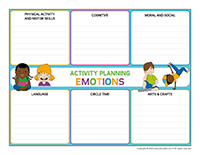
NEW! (Open interactive planning-Emotions) Print and use the document to present activities related to the theme for your group.
SPECIAL TOOL
NEW! For each theme, a printable tool is created in response to a special request that we received. (Open my emotions coloring chart) Print for each child. Use the chart daily to encourage children to express their emotions. Invite them to color a box each time they successfully name their emotions. At the end of the week, discuss the results.
CIRCLE TIME
NEW! Discussion period-Emotions
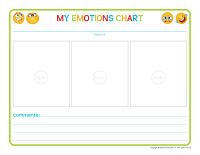
(Open circle time game-Emotions) Print and laminate the characters representing various emotions as well as the cards describing different situations that can lead us to feel emotions. Distribute the characters among the children in your group. Pick one situation at a time. The child who has the corresponding character must show it to the group and name the emotion. Encourage children to describe other situations that can cause each emotion. Beware! For certain situations, there is more that one possible answer. This is great for fostering a discussion.
Creating an emotions hat
Simply find a paper hat on which you can glue tiny characters representing different emotions.
Hidden emotions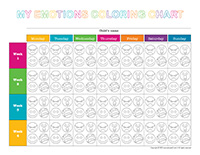
Hide several characters representing various emotions or emojis throughout your daycare. Ask children to search for them and set them in a basket in the center of a table. Use the characters to spark a conversation about emotions.
Emotions characters
During circle time, use drawings representing characters displaying different emotions to explore emotions with your group. (Open emotions characters) Laminate the characters and cut them out. Invite children to pick a character that represents how they are feeling and encourage them to explain their choice. If you wish, display the characters on your daycare walls so that children can refer to them throughout the day. When a difficult situation arises, children can use the characters to recognize their emotion. The characters can be used many ways. For example, they can be used for a mime game.
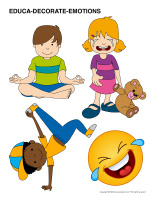 AREA SETUP
AREA SETUP
NEW! Thematic poster-Emotions
(Open thematic poster-Emotions) Print and display.
NEW! Educa-decorate-Emotions
(Open educa-decorate-Emotions) Print, laminate, and cut out the items. Use them to decorate your daycare walls and set the mood for the theme.
NEW! Educa-theme-Emotions
(Open educa-theme-Emotions) Print and laminate the different elements representing the theme. The items can be used to present the theme to children (and their parents) or simply to decorate your daycare for the theme.
Garland-Emotions with Poni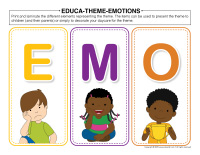
(Open garland-Emotions with Poni) Print and invite children to decorate the elements. Cut them out and hang them within your daycare or near your daycare entrance.
NEW! Erasable chart-Emotions
(Open erasable chart-Emotions) Print a chart for each child. Encourage them to personalize their chart by writing their name or using stickers. The goal is simply for them to readily be able to recognize their chart. Laminate the charts and display them on a wall next to your daycare entrance. Upon their arrival each morning, children can use their chart to communicate how they are feeling by drawing the corresponding expression using a dry-erase marker. If needed, they can change the displayed emotion during the day. Simply set a moist towel nearby. Children can use it to erase what they previously drew if they wish to do so.
Emotions mural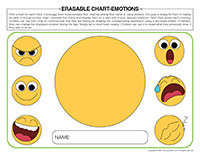
Cut various pictures of people out of magazines and ask children to use them to create a mural representing different emotions. Under each picture, write a word related to emotions. Add children’s drawings and pictures of the children in your group to your mural throughout the theme.
NEW! Pennants-Emotions
(Open pennants-Emotions) Print the pennants and have children color and decorate them. Assemble them to form a garland that can be hung in your daycare entrance
NEW! Emotion jars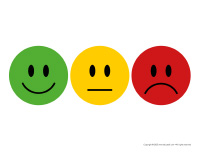
(Open jars-Emotions) Print and glue the items on a series of containers or jars. (Open pictograms emotions) These pictograms represent emotions that children frequently experience. Print them and laminate them so that you can integrate them in different games and activities. For example, they can be used for mime games. You can also choose to display them on your daycare walls so that children can refer to them when a situation sparks an emotion. They represent an interesting tool to help children recognize and name their emotions.
PICTURE GAME
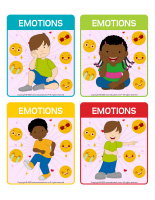 NEW! The pictures may be used as a memory game or to spark a conversation with your group. Use them to decorate the daycare or a specific thematic corner. (Open picture game-Emotions) Print, laminate, and store in a Ziploc bag or thematic bin.
NEW! The pictures may be used as a memory game or to spark a conversation with your group. Use them to decorate the daycare or a specific thematic corner. (Open picture game-Emotions) Print, laminate, and store in a Ziploc bag or thematic bin.
WRITING AND ACTIVITY SHEETS
NEW! Activity sheets-Emotions
Activity sheets are suggested for each theme. Print and follow instructions. (Open activity sheets-Emotions) (Open activity sheets-Emotions with Poni)
WRITING ACTIVITY
NEW! (Open writing activities-E like Emotion) Print for each child or laminate for use with a dry-erase marker.
Stationery-Emotions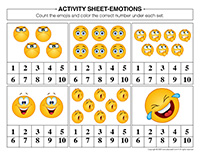
The thematic stationery can be used to communicate with parents, in your writing area, or to identify your thematic bins. (Open stationery-Emotions) Print.
LANGUAGE ACTIVITIES
NEW! Word flashcards
The flashcards may be used to spark a conversation with your group, in your reading and writing area, or even to identify your thematic bins.(Open word flashcards-Emotions) or (Open giant word flashcards-Emotions) happy, sad, angry, joyful, excited, calm, satisfied, worried, surprised, playful, mischievous, proud
So many reasons to be happy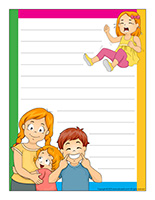
Cut a large circle out of yellow cardboard. Using a permanent marker, draw a smiling face on the circle and glue it in the center of a large piece of white cardboard. Invite children to name a multitude of things that make them happy and make them want to smile. Write or draw the corresponding things or situations around your smiley face.
NEW! Dice game-Emotions
(Open dice game-Emotions) Print the words for the dice and glue them on the various faces of 2 small cardboard boxes. Children take turns rolling these dice and responding to the phrases created by combining them.
Emotions ladder
(Open emotions ladder) Print and laminate. This tool is very efficient with children who are 3 years old or older, mainly because it works on two levels. With its illustrations, the ladder helps children realize how their emotions can escalate as well as how they feel before they finally explode in anger, for example. On the other hand, on the righthand side of the ladder, solutions are suggested for each step. The emotions ladder applies to daily life, especially with children who tend to get angry very easily. Children will need your support to integrate the ladder’s concepts adequately.
Let’s chat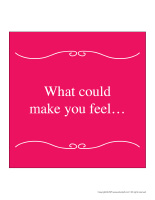
Print and laminate the word flashcards. Have each child pick a word flashcard. They can take turns presenting their word to the group (ex. sad). Discuss each emotion and ask children questions to foster conversation.
Sequential story
(Open sequential story-Emotions) Print and laminate the different scenes. Have children place them in the correct order to reconstitute the story.
PHYSICAL ACTIVITY AND MOTOR SKILLS
Emotions hop
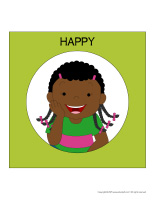 Using sidewalk chalk, draw large emojis one after the other on an asphalted surface in your yard. Encourage children to stand on an emoji. Call out a number. Children must perform the corresponding number of hops. If they reach the final emoji before completing the requested number of hops, they can run back to the first emoji to complete the missing hops. Children mime the emotion they land on momentarily. For example, the child who lands on the sad face could pretend to cry. Continue the game by calling out another number.
Using sidewalk chalk, draw large emojis one after the other on an asphalted surface in your yard. Encourage children to stand on an emoji. Call out a number. Children must perform the corresponding number of hops. If they reach the final emoji before completing the requested number of hops, they can run back to the first emoji to complete the missing hops. Children mime the emotion they land on momentarily. For example, the child who lands on the sad face could pretend to cry. Continue the game by calling out another number.
NEW! Pasta faces-Emotions
(Open pasta faces-Emotions) Print for each child. Set a bowl filled with different types of uncooked pasta on the table. Children must glue pasta pieces to represent the illustrated emotions.
The emotions dance
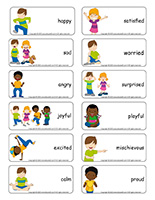 Prior to this activity, select a few musical pieces that can be associated to common emotions. For example, a very slow musical piece could be associated with sadness, whereas music containing very loud sounds could represent anger, and a musical piece with a very rapid rhythm could be associated with happiness. Listen to the different musical pieces with your group. Together, find movements and gestures that represent the corresponding emotions, such as stomping your feet heavily when you hear drums. Next, alternate the musical pieces. Children will quickly learn how they can represent emotions through dancing.
Prior to this activity, select a few musical pieces that can be associated to common emotions. For example, a very slow musical piece could be associated with sadness, whereas music containing very loud sounds could represent anger, and a musical piece with a very rapid rhythm could be associated with happiness. Listen to the different musical pieces with your group. Together, find movements and gestures that represent the corresponding emotions, such as stomping your feet heavily when you hear drums. Next, alternate the musical pieces. Children will quickly learn how they can represent emotions through dancing.
NEW! Imitation game-Emotions
(Open imitation game-Emotions) Print, laminate, and cut out the cards. Divide them into 2 piles : animals and emotions. Children take turns picking a card from each pile. For example, if a child picks a kangaroo and excitement, he could quickly execute a series of large hops within the daycare.
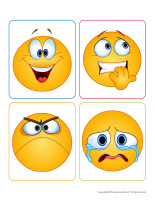 NEW! Modeling dough activity placemats-Emotions
NEW! Modeling dough activity placemats-Emotions
(Open modeling dough activity placemats-Emotions) Print and laminate. Let children pick a placemat and provide modeling dough. Encourage them to use the dough to fill or reproduce the shapes that are on their placemat.
Energy expenditure area
For this theme, you can add a child size “punching bag”, cushions that can be tossed, and piles of scrap paper that children can crumple and throw in a garbage can in a special “energy expenditure” area.
Goodbye anger
Set up a special area where children can expend their anger and calm themselves. Add a pillow that they can punch, modeling dough that they can manipulate, and a headset that they can use to listen to calming music.
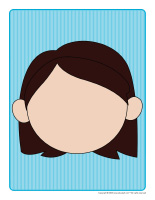
Animal sounds
Making animal sounds is a great way to calm children’s emotions. For example, you can invite children to get down on all fours and roar like a lion.
Emotions ball
Stand in a circle with your group. Toss a ball to a child as you say a kind word. The child must toss it back to you and pronounce a kind word. Work your way around the circle to spread happiness.
Mr. Potato Head fun
Encourage children to create a Mr. Potato Head character. Ask them to present their character to the group and encourage them to share which emotion is represented by his expression.
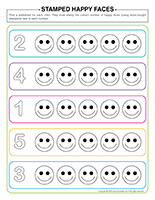
COGNITIVE ACTIVITIES
NEW! Stamped happy faces
(Open stamped happy faces) Print a worksheet for each child. They must stamp the correct number of happy faces (using store-bought stampers) next to each number.
NEW! Color and cut out puzzles
(Open color and cut out puzzles) Print for each child. Read the sentences to help children determine which color they must use to color the different emotions. Next, have them cut out the pieces and associate the half faces that go together.
NEW! Coloring hunt and seek-Emotions
(Open coloring hunt and seek-Emotions) Print and laminate. Children must find and color the items in the scene.
Bingo-Emotions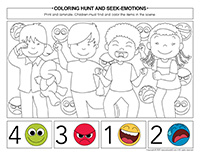
Play bingo with your group. (Open bingo-Emotions) Print, laminate, and cut out the pieces. Store them in a small box or in a resealable bag.
Educ-trace-Emotions
(Open educ-trace-Emotions) Print for each child. Children trace the dotted lines with a marker of the corresponding color and then color the item at the end of each line using the same color.
Educ-colors-Emotions
(Open educ-colors-Emotions) Print and laminate for durable, eco-friendly use. If you prefer, print the document for each child. Children must cut out the shapes/faces at the bottom of the page and glue each one in the corresponding shape outline.
Color by number-Emotions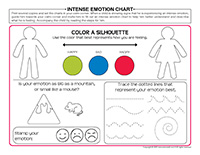
(Open color by number-Emotions) Print for each child. They must color the scene per the color code.
Educ-association-Emotions
(Open educ-assocation-Emotions) Print and glue the first two pages in a file folder. Cut out the cards on the last two pages and encourage children to set them on the corresponding image in the file folder.
Educ-math-Emotions
(Open educ-math-Emotions) Print and laminate for durable, eco-friendly use. Children must count the items in each rectangle and circle the correct number.
Educ-same and different-Emotions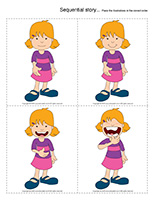
(Open-educ-same and different-Emotions) Print and laminate for durable, eco-friendly use. Children must circle the item that is different in each row.
Educ-pattern-Emotions
(Open educ-pattern-Emotions) Print and laminate the game. Children must complete each pattern by pressing the appropriate cards in the empty boxes.
Silly bingo
Play bingo with your group. (Open silly bingo) Print, laminate, and cut out the pieces. Store them in a small box or in a resealable bag.
MORAL AND SOCIAL ACTIVITIES
NEW! My intense emotion chart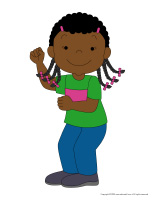
(Open intense emotion chart) Print several copies and set the charts in your calm corner. When a child is showing signs that he is experiencing an intense emotion, guide him towards your calm corner and invite him to fill out an intense emotion chart to help him better understand and describe what he is feeling. Accompany the child by reading the steps for him.
Overflowing emotions
Give each child an empty toilet paper roll. Invite them to draw a face on their cardboard tube to represent an emotion. Have them arrange the cardboard tubes vertically (so they are standing up) in a shallow container. Next, have them pour 2 tablespoons of baking soda in each cardboard tube. They can add a few drops of food coloring too. Encourage them to choose a color that, in their opinion, can be associated with the emotion they drew on their toilet paper roll. Once this is done, pour vinegar inside the tubes. The “potion” will overflow. Use this activity to discuss emotional outbursts with the children in your group.
NEW! My emotions chart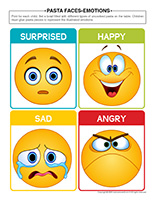
(Open my emotions chart) Print and laminate for each child. Use the chart daily to help children identify their emotions.
NEW! Colorful emotions
(Open colorful emotions) Print, laminate, and display in your calm corner. Use the posters when needed to help children understand their emotions. Associating their emotion with a color will help them better undersand and welcome it.
Family emotions
(Open family emotions) Print two copies for each child. Invite parents to draw things that make their child happy and things that make him sad. The following day, invite children to draw what makes them happy and sad. Compare the results.
Photo session-Emotions
Invite the children in your group to represent dif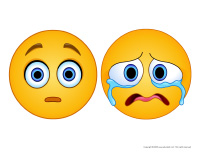 ferent emotions using facial expressions. Photograph them and print the pictures. Use them to decorate your daycare. Refer to the pictures whenever necessary.
ferent emotions using facial expressions. Photograph them and print the pictures. Use them to decorate your daycare. Refer to the pictures whenever necessary.
Emotions box
Create your own emotions box (children can decorate it as they see fit) and set it in a corner within your daycare. Children can fill the box with their emotions. Show them how they can remove the lid and speak into the box or add a drawing representing their emotions to it.
My emotions
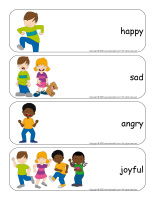 (Open my emotions with Poni handbook) Print. Throughout the theme, ask children questions about different emotions. For example, you can ask them what happens to them when they get angry. Write their responses in their handbook. Encourage them to represent the corresponding emotion with their face. Photograph them and print the pictures so that they can be added to their book. This handbook is a long-term project, but it goes a long way in helping children understand their emotions.
(Open my emotions with Poni handbook) Print. Throughout the theme, ask children questions about different emotions. For example, you can ask them what happens to them when they get angry. Write their responses in their handbook. Encourage them to represent the corresponding emotion with their face. Photograph them and print the pictures so that they can be added to their book. This handbook is a long-term project, but it goes a long way in helping children understand their emotions.
Mirror game
Invite children to mime different emotions in front of a mirror.
Emotional mimes
Children sit facing a partner and have fun taking turns imitating each other’s facial expressions.
Heartfelt mail
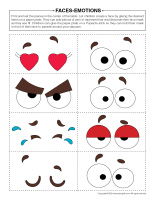
Invite each child to prepare one or more drawings for their peers. Encourage them to deposit their drawings in a special mailbox that you decorated as a group. Distribute the drawings. When a child recognizes one of his drawings, he can explain what it represents to its recipient. This activity can last a day, a week, or the entire duration of the theme.
Standing ovation
Designate a child each day who can, as often as he wishes, request a standing ovation simply by saying, “I would like a standing ovation please.” Upon each request, his peers must stand and applaud him loudly.
Silly face
Give each child a large pickle. When you give them the signal, they must bite it. Observe their facial expressions and photograph them.
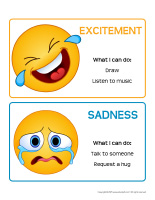
ARTS & CRAFTS
Balloon faces
Provide a few uninflated party balloons in a variety of colors. Children can use permanent markers to draw faces representing different emotions on the balloons (lay the balloons flat on a table, with the opening at the top). When they are done, help them inflate the balloons. They can knot colorful pieces of ribbon around the tip of each balloon to represent hair. Children will love tossing these balloon faces up in the air.
Breath sticks
Have each child pick a pipe cleaner. Help them fold one end of their pipe cleaner (approximately 5 cm) to create a small handle. Next, have them slide 10 necklace beads on their pipe cleaner. Twist the other end so that the beads won’t fall off. Show children how they can touch one bead at a time, breathe in deeply, and then slide it along their pipe cleaner as they breathe out. Once all the beads have been moved to the opposite end of their pipe cleaner, they will have taken 10 deep breaths… and feel very calm. Use these breath sticks as often as necessary.
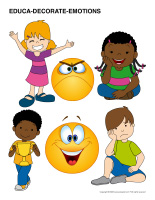
Emotions ladder
(Open emotions ladder) Print, laminate, and cut out the ladders. Invite children to pick the ladder they prefer. Using a hole-punch, have them punch a hole near the top and bottom of their ladder. They insert one end of a pipe cleaner containing a necklace bead in each hole, turn their ladder over, fold the ends of their pipe cleaner over, and add pieces of adhesive tape to secure the pipe cleaner ends in place. Children can slide the bead up or down their ladder to indicate the intensity of their emotion.
NEW! Models-Emotions
(Ouvrir models-Emotions) Print several copies. Use the models for arts & crafts projects, to practice cutting skills, or for various activities throughout the theme.
NEW! Puppets-Emotions
(Open puppets-Emotions) Use the puppets for their "creative" aspect. Children will enjoy making them talk and interact. You will find several puppet templates in the Educatall Club.
Emotions mural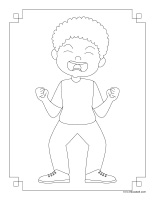
Cut several different facial features (eyes, noses, mouths, etc.) out of magazines and invite children to use them to represent faces on a large piece of paper.
NEW! Emotions masks
(Open faces-Emotions) Print and set the pieces in the center of the table. Let children create a face by gluing the desired items on a paper plate. They can add pieces of yarn to represent hair and decorate their face mask as they see fit. Children can glue the paper plate on a Popsicle stick so they can hold their mask in front of their face to parade around your daycare.
COLORING PAGES
NEW! Coloring pages theme-Emotions
(Open coloring pages theme-Emotions) Print for each child.
Have fun !
The educatall team
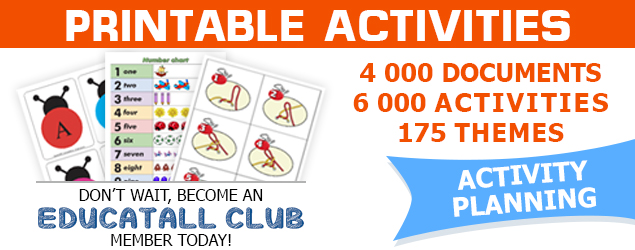
 Home
Home Theme activities
Theme activities
 Babies and toddlers
Babies and toddlers
 Arts and crafts
Arts and crafts
 Science
Science
 Creative recipes
Creative recipes
 Tips and tricks
Tips and tricks
 Special needs
Special needs
 Extra activities
Extra activities
 Educ-TV
Educ-TV
 Newsletter
Newsletter  Online store
Online store Educatall club
Educatall club

